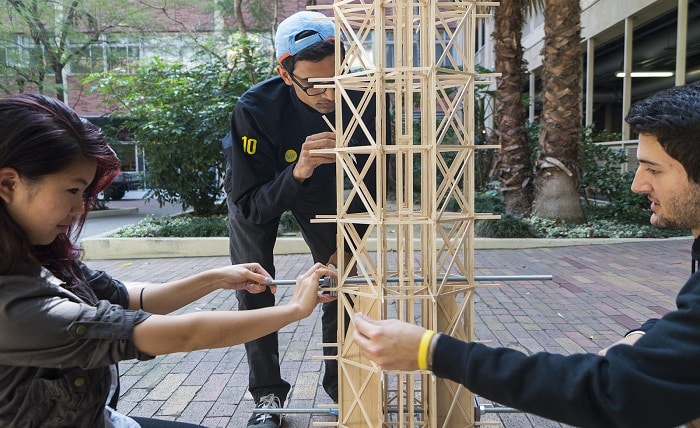Design Principles For Earthquake-Resilient Buildings

In regions prone to seismic activity, the construction of earthquake-resilient buildings is not just a matter of compliance but a necessity.
Earthquakes present a formidable challenge to architects and engineers, pushing them to innovate and adapt in the face of nature’s unpredictability.
This blog post delves into the fundamental design principles that these professionals use to create structures capable of withstanding the destructive forces of earthquakes.
It emphasizes the crucial role of structural civil engineering, a field dedicated to understanding and applying these principles effectively.
Through a comprehensive exploration of material selection, design strategies, and technological advancements, this post aims to shed light on how modern construction meets the demands of seismic resilience, ensuring safety and durability in earthquake-prone areas.
Here’s a List of Some of the Top Places in the World Where Earthquake-Resilient Construction Is Most Crucial:
- Japan
Renowned for its seismic activity, Japan is at the forefront of implementing advanced earthquake-resistant construction techniques. Cities like Tokyo and Kobe are notable examples.
- California, USA
Particularly in areas like San Francisco and Los Angeles, which are situated near the San Andreas Fault, earthquake-resistant buildings are vital.
- Chile
Chile experiences significant seismic activity due to its location along the Pacific Ring of Fire. Cities like Santiago and Valparaíso have stringent building codes for earthquake resilience.
- New Zealand
Especially in regions like Christchurch, which was struck by a devastating earthquake in 2011, earthquake-resilient construction is a priority.
- Turkey
Istanbul and other Turkish cities are prone to earthquakes, making the construction of earthquake-resistant buildings a key focus for safety.
- Indonesia
With a history of destructive earthquakes and tsunamis, Indonesia, especially regions like Sumatra and Java, requires robust earthquake-resistant construction.
- Mexico
Mexico City and other areas are known for their seismic activity, leading to a high demand for earthquake-resistant buildings.
- Italy
Regions like L’Aquila and Naples are earthquake-prone, prompting the need for buildings designed to withstand seismic events.
- Nepal
After the major earthquake in 2015, Nepal has been focusing on rebuilding with earthquake resilience in mind, particularly in Kathmandu.
- Iran
Iran, particularly Tehran, is in a major seismic zone, necessitating the construction of earthquake-resistant buildings to protect its dense population.
In these regions, the principles of earthquake-resilient construction are not just a matter of compliance but are essential for safeguarding lives and infrastructure.
Core Design Principles
Alright. Now, let’s talk about some of the core design principles that are essential for this type of construction.
- Flexibility and Ductility
One of the key principles in earthquake-resistant design is ensuring that buildings can bend without breaking.
This concept, known as ductility, allows structures to absorb and dissipate seismic energy, reducing the likelihood of catastrophic failure.
- Strong Foundation and Ground Considerations
The foundation is critical in seismic design.
Engineers must consider soil type, potential liquefaction, and other geotechnical factors.
A well-designed foundation can greatly increase a building’s ability to withstand seismic forces.
- Load Path Continuity
A continuous load path is essential to ensure that the forces generated by an earthquake are efficiently transferred through the building and into the ground.
This involves careful alignment and connection of structural elements from the roof down to the foundation.
- Redundancy and Uniformity
Redundancy in structural design ensures that if one component fails, others can take over the load-bearing responsibility, preventing overall collapse.
Uniformity in stiffness and strength across the building reduces the likelihood of irregular movement and damage during a quake.
- Use of Seismic Dampers and Isolators
Advanced technologies like base isolators and dampers are increasingly used in earthquake-resistant buildings.
These devices absorb seismic energy and provide a buffering effect, reducing the force transmitted to the structure.
- Simplified and Symmetrical Geometry
Simple and symmetrical buildings tend to perform better in earthquakes.
Complex shapes can lead to unexpected stress concentrations and torsional movements during seismic events.
- Regular Inspection and Maintenance
Regular upkeep is vital for maintaining the seismic resilience of a building.
This includes routine checks and repairs of the structural and non-structural elements.
The Role of Structural Civil Engineering
Structural civil engineering plays a pivotal role in the design and construction of earthquake-resilient buildings.
This branch of engineering deals with the analysis and design of structures that support or resist loads, ensuring that buildings are not only safe but also functional and economical.
A structural civil engineer’s expertise is critical in selecting the right materials, determining the most effective design approach, and ensuring that the building adheres to all seismic codes and regulations.
If you want to learn more about structural civil engineering, you can check out this blog post, which delves deeper into the technical aspects and innovative practices in this field.
Conclusion
Building earthquake-resilient structures is a complex task that requires a deep understanding of seismic forces and the principles of structural dynamics.
By adhering to these design principles and leveraging the expertise of structural civil engineers, we can create safer, more durable buildings capable of withstanding seismic events.





I appreciate you sharing this blog post. Thanks Again. Cool.